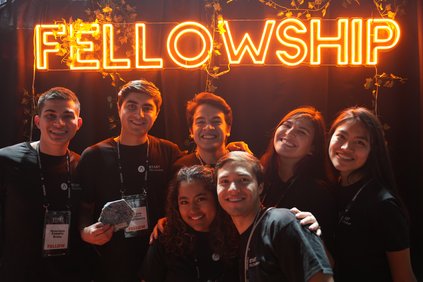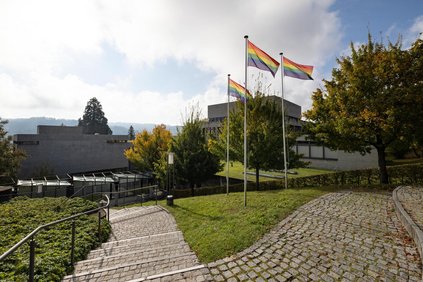Background - 18.10.2023 - 08:25
How does the inclusion of people with disabilities succeed in business and society?
"The Art of Small Steps: How does inclusion succeed?" This was the topic of a roundtable discussion on October 16 at SQUARE with film critic Alex Oberholzer as well as Dr. Louisa Blödorn and Prof. Dr. Stephan Böhm from the Center for Disability and Integration. A review.

"The Art of Small Steps: How does inclusion succeed?" This was the topic of a roundtable discussion at SQUARE with film critic Alex Oberholzer as well as Louisa Blödorn and Stephan Böhm from the CDI-HSG.
16% of the world's population lives with a visible or non-visible disability, according to an estimate by the World Health Organization. Despite the high percentage, inclusion is still treated as a fringe issue in many organizations. Creating an inclusive environment requires leadership, an opinion held by the three interviewees.
More visibility and self-evidence
Addressing the crowd attending the roundtable, Alex Oberholzer began to read. The room went quickly silent. The renowned film critic began the discussion by reading lines from his book "Im Paradies der weissen Häubchen." A book about his childhood. He shared his personal experiences about what it meant to grow up with a disability in a children's hospital in the 1950s and 1960s, isolated from the world. The subsequent transition to the outside world was painful and required courage, the author described. Until he finally discovered his passion for films and pursued his appointment as a film editor and critic.
For Alex Oberholzer, "successful inclusion" means above all the visibility and self-evidence of people with disabilities in society: "For me, it was enormously important that when I entered a restaurant, I was no longer looked at because I was in a wheelchair, but because people said: I know him from the radio! The wheelchair was of secondary importance.
Stephan Böhm, Professor of Diversity Management and Leadership and Director of the CDI-HSG, emphasized the importance of promoting inclusion as part of the corporate culture in terms of a "mindset." The CDI-HSG thus developed the St.Gallen Inclusion Index to measure inclusion. In addition to the sense of belonging, the index also measures the perception of authenticity, equal opportunities and diversity of perspectives as important dimensions of inclusion found in companies.
More awareness
During the discussion, it became clear "that we are far from reaching our goal when it comes to inclusion," stated HSG researcher Louisa Blödorn, who moderated the event. Even though some things have improved over the past decades, there is still a long way to go in terms of infrastructural accessibility. According to Alex Oberholzer, public transport in particular presents difficulties for many of those affected. Access to the labour market is also still difficult, especially for people with severe disabilities; the labour force participation rate of 39% is still significantly lower than that of people without disabilities (84%; Federal Office for Statistics, as of 2019).
Louisa Blödorn shared insights from a recent research project at CDI-HSG on inclusion in the workplace. There is often a lack of awareness and education among managers and employers. A particular challenge, Stephan Böhm pointed out, is that most disabilities are simply not visible – including mental health problems, autism, ADHD or chronic pain. It is therefore important for companies and managers to create an environment in which employees feel safe to speak openly about disabilities and needs.
Relying on trust and dialogue
The big question that came up in the end was, "What can each and every individual do to be more inclusive?" Two solutions were mentioned: Build trust and cultivate dialogue. According to Alex Oberholzer, it is precisely the encouragement of the immediate environment that is essential. As a child, it was the nurses who "inoculated" him with a strong form of self-confidence through encouraging encouragement, which ultimately gave him enormous strength for his life's journey. Later, it was the confidence of his superiors in him and his abilities that helped him to follow his demanding professional career path.
The interdisciplinary center CDI-HSG has been conducting research on the professional inclusion of people with disabilities for 15 years. In the work context, a central role is attributed to managers in particular – for example, "strength-oriented leadership" that specifically promotes the strengths of individual employees can set an important course, said Stephan Böhm. Research by the CDI-HSG has shown that inclusive companies have healthier, more productive and more satisfied employees, he said.
"Together, many small steps can often achieve great things after all," Louisa Blödorn concluded the roundtable.
A report, article, piece by the Center for Disability and Integration (CDI-HSG).
Image: CDI-HSG
More articles from the same category
This could also be of interest to you
Discover our special topics



![[Translate to English:] Choix Goncourt de la Suisse | unisg.ch](https://www.unisg.ch/fileadmin/_processed_/b/a/csm_Choix_Concourt_de_la_Suisse_HT-Stibi-069_2110740678.jpg)












